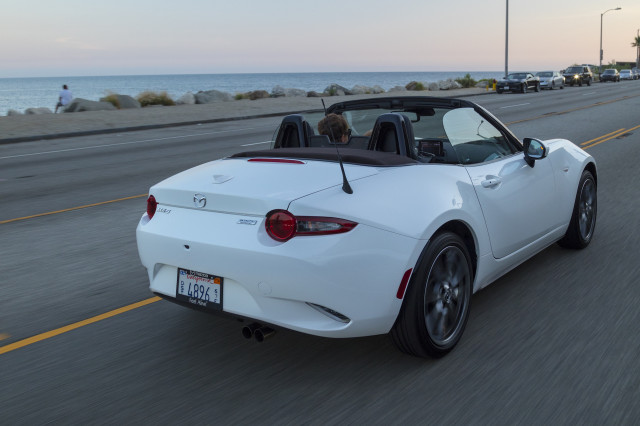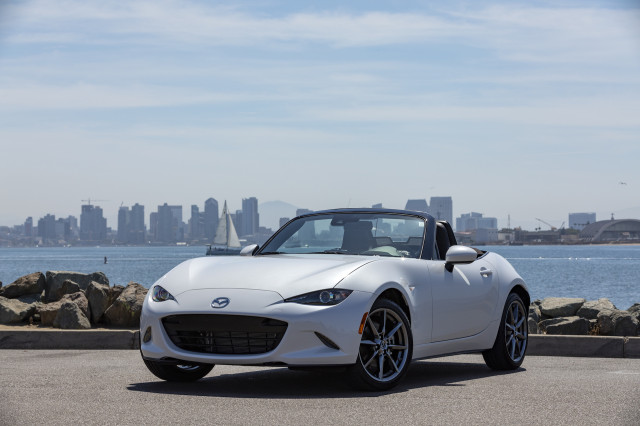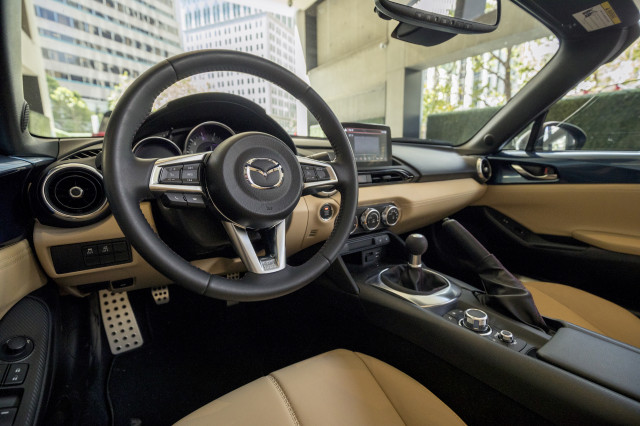2019 Mazda MX-5 Miata first drive review: the sports car Mazda intended
The new Mazda MX-5 Miata we got in the U.S. in 2016 wasn’t really the car it was supposed to be. According to Mazda North American Operations manager of vehicle dynamics Dave Coleman, Mazda wanted to use a 1.5-liter 4-cylinder engine worldwide.
Pushback from the U.S. allowed installation of Mazda’s 155-horsepower 2.0-liter SkyActiv-G 4-cylinder instead, for a useful power bump over the 129-horsepower 1.5-liter used in other countries. But that 2.0-liter engine was little more than a transplanted version of the engine used in the company’s economy models and it had some shortcomings in sports car duty.
DON'T MISS: 2016 Mazda MX-5 Miata first drive review
The aim for the updated 2019 Miata was to give the roadster a proper version of the 2.0, and Mazda has succeeded, even if this new engine falls unexpectedly short of some of Mazda’s claims for it.

2019 Mazda MX-5 Miata

2019 Mazda MX-5 Miata

2019 Mazda MX-5 Miata
A question of revs
The off-the-shelf SkyActiv-G 2.0-liter engine installed in the 2016-'18 ND Miata was optimized for efficiency, and spun to a maximum of 6,800 rpm before hitting the rev limiter’s fuel cutoff. The 1.5-liter engine was tuned properly for a sports car, revving to 7,500 rpm, so despite its lesser power output, it produced the kind of excitement drivers expect from the MX-5.
It was also a cause for concern among buyers and some within Mazda that, at 155 horsepower, the 2.0-liter engine was rated lower than the 167-horsepower 2.0-liter engine in the previous-generation car, the so-called NC.
Now, the ND is renamed ND1, and the 2019 edition becomes the ND2, to reflect the engine upgrade. The extensive changes include a throttle that flows 28 percent more air, revised intake and exhaust ports for improved airflow, and revised intake and exhaust manifolds that flow more air and fuel through the engine.
Spinning the engine faster also called for lighter pistons and connecting rods, with a strengthened crankshaft. “The pistons in this engine are works of art,” enthused Coleman. “I didn’t think there was any way possible to take weight of out (the previous pistons), but we did it,” he crowed. Mazda trimmed 27 grams from each piston to help the engine rev more freely.
The direct fuel injection now fires as many as three distinct injections at lower rpm, up from the previous two, and those squirts of gas are at higher pressure for improved atomization of the fuel.
All of these changes improve both efficiency and power. The 2.0 in the 2019 Miata produces 181 hp and 151 pound-feet of torque, gains of 26 and 3, respectively. Even though the ND2 is more powerful, its EPA highway fuel economy rating with the manual transmission improves by 1 mpg to 34 mpg, while the city and combined numbers are unchanged at 26 mpg and 29 mpg, respectively.

2019 Mazda MX-5 Miata

2019 Mazda MX-5 Miata

2019 Mazda MX-5 Miata
The automatic transmission car employs a lower final-drive ratio for quicker acceleration, but the efficiency gains let the EPA rating hold steady for that car at 26 city, 35 highway, 29 mpg combined.
In response to concerns about annoying gear rattle sounds from the old engine, the ND2’s engine uses a dual-mass flywheel that quells vibration. “Dual-mass” normally means “too much mass,” as it requires two sections connected by damping springs, but Mazda designed a light flywheel that retains the kind of rapid throttle response Miata drivers demand, according to Coleman.
Mazda used software to mitigate another issue with manual transmission cars. Programming for the throttle-by-wire system modulates the opening of the throttle plate to automatically squash any of the oscillations that are typical when accelerating from low rpm.
As a cherry on top, Mazda redesigned the Miata’s muffler. Now it sounds even better than before, and it sounded great before.
Email This Page